.
Some elephants like olive oil, and others do not. If there is a bit of iron in the inside of an elephant it is said that it will pass out if the animal takes a drink of olive-oil; if the animal refuses olive-oil, they soak a root in the oil and give it the root to swallow. Aristotle, History of Animals, Book 8
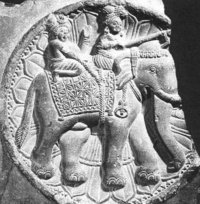
Indian war elephant, relief at Mathura, 2nd century BC [Source]
War elephants were important, although not widespread, weapons in ancient military history. Their main use was in charges, to trample the enemy and/or break their ranks. War elephants were exclusively male animals, as they are faster and more aggressive.
History
Elephant taming began in the Indus valley around 4,000 years ago. Taming is not used here as a synonym of domestication. Domesticated animals, such as cows or dogs, are born in captivity and eventually subjected to selective breeding. Elephants, probably due to their bad temper, expensive feeding and slow growth rate (15 years to adulthood), were, with very few exceptions, always caught in the wild and subsequently tamed for several purposes. The first species to be tamed was thus the Asian elephant, for agricultural ends. The first military application of elephants dates from around 1100 BC and is mentioned in several Sanskrit hymns.
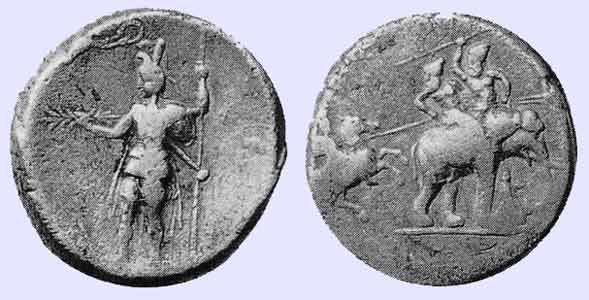
Coin commemorating Alexander's campaigns in India, struck in Babylon around 323 BC.
Obv: Alexander standing, being crowned by Nike, fully armed and holding Zeus' thunderbolt.
Rev: Greek rider, possibly Alexander, attacking an Indian battle-elephant, possibly during the battle against Porus.
From the East, war elephants migrated to the Persian empire where they were used in several campaigns. The battle of Gaugamela (October 1, 331 BC), fought against Alexander the Great was probably among the first confrontations of Europeans with war elephants. The fifteen animals, placed at the centre of the Persian line, made such an impression on the Macedonian troops that Alexander felt the need to sacrifice to the god of fear in the night before the battle. Gaugamela was Alexander's greatest success, which he won by carefully placing his cavalry away from the elephants. Following his conquest of Persia, Alexander recognised the use of the animals and incorporated a number of them in his army. Five years later, in the battle of the Hydaspes River, although without his own, Alexander already knew how to deal with elephants.
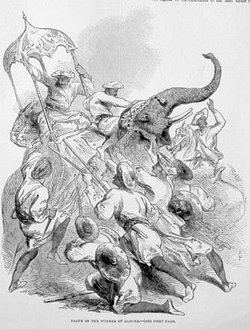
Charging elephants caused terror and panic, and their thick hides made them difficult to injure or kill. [Source]
The successful military use of elephants spread across the world. The successors to Alexander's empire, the Diadochi, used hundreds of Indian elephants in their wars. The Egyptians and the Carthaginians began taming African elephants for the same purpose, while the Numidians used the Forest elephant. The African savannah elephant, larger than the African forest elephant or the Asian elephant, proved too difficult to tame for war purposes and was never widely used. Elephants used by Egyptians at the battle of Raphia in 217 BC were smaller than their Asian counterparts, but that did not guarantee victory for Antiochus III the Great of Syria.

Armor for War Elephants (here a headpiece is used).
In the next centuries, further use of war elephants in Europe was mainly against the Roman Republic. From the battle of Heraclea (280 BC, Macedonian Wars) to the famous march across the Alps by Hannibal during the Second Punic war, elephants terrified the Roman legions. Like Alexander, the Romans found a way to cope with the dangerous elephant charges. In Hannibal's last battle (Zama, 202 BC), his elephant charge was ineffective because the Roman maniples simply made way for them to pass. More than a century later, in the battle of Thapsus (February 6, 46 BC), Julius Caesar armed his fifth legion (Alaudae) with axes and commanded his legionaries to strike at the elephant's legs. The legion withstood the charge and the elephant became its symbol.
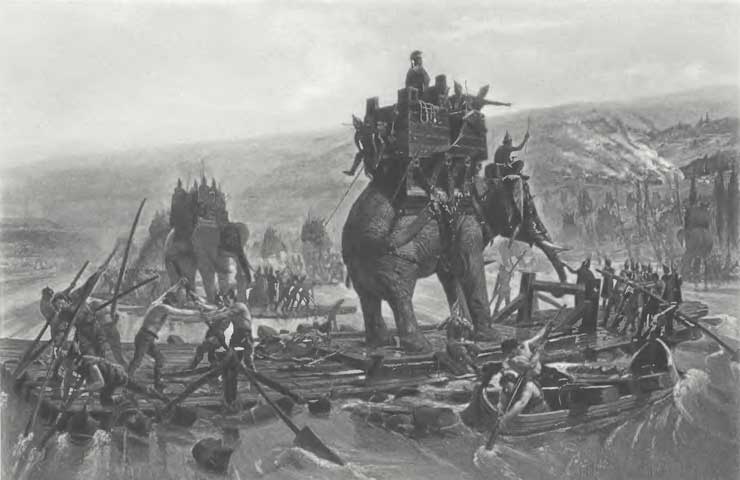
Transport of war elephants, Hannibal crossing the Rhone, Henri-Paul Motte
A reportedly effective anti-elephant weapon was the pig. Pliny the Elder reported that "elephants are scared by the smallest squeal of a pig" (VIII, 1.27). A siege of Megara was reportedly broken when the Megarians poured oil on a herd of pigs, set them alight, and drove them towards the enemy's massed war elephants. The elephants bolted in terror from the flaming squealing pigs.
In the Middle Ages, elephants were seldom used. Charlemagne took his elephant, Abul-Abbas, when he went to fight the Danes in 804, and the Crusades gave Frederick II, Holy Roman Emperor the opportunity to capture an elephant in the Holy Land, later used in the capture of Cremona in 1214.
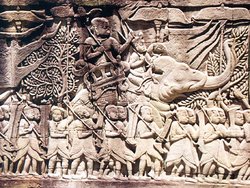
The Khmer army waged war with elephants against the Cham in the 12th century [Source].
It was the use of elephants, again by an Indian Sultanate, that almost put an halt to Timur's conquests. In 1398 Timur's army faced more than one hundred Indian elephants in battle and almost lost by pure fear of his troops. Historical accounts say that the Turks won due to an ingenious strategy: Timur set flaming straw on the back of his camels before the charge. The smoke made the camels run forward and scared the elephants, who crushed their own troops in an attempt to retreat. Another account of the campaign (that of Ahmed ibn Arabshah) reports that Timur used oversized caltrops to halt the elephant charge. Later, the Turkic leader used the animals against the Ottoman Empire.
With the advent of gunpowder warfare in the late 15th century, war elephants became obsolete as a charging element because they could be easily knocked down by a cannon shot.
Tactical use
There were plenty of military purposes for which elephants could be used. As enormous animals, they could carry heavy cargoes and provided a useful means of transport. In battle, war elephants were usually deployed in the centre of the line, where they could be useful to prevent a charge or start one of their own.
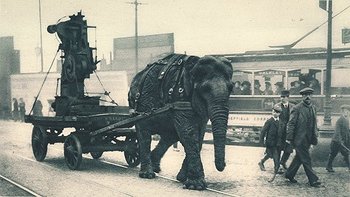
During World War I, elephants pulled heavy equipment. This one worked in a munitions yard in Sheffield [Source].
An elephant charge could reach about 30 km/h and unlike horse cavalry, could not be easily stopped by an infantry line setting spears. Its power was based on pure force: it would crash into an enemy line, trampling and swinging its tusks. Those men who were not crushed were at least knocked aside or forced back. Moreover, the terror elephants can inspire against an enemy unused to fighting them (such as the Romans) could cause him to break and run just on the charge's momentum alone. Horse cavalry were not safe either, because horses unaccustomed to the smell of elephants panicked easily. Elephants' thick hide make them extremely difficult to kill or neutralize in any way, and their sheer height and mass offered considerable protection for their riders. Unfortunately, they also had tendency to panic themselves: after sustaining moderate wounds or when their driver was killed, they would run amok, indisciminately causing casualties as they sought escape. Their panicked retreat could inflict heavy losses on either side. Experienced Roman infantry often tried to sever their trunks, causing an instant panic, and hopefully causing the elephant to flee back into its own lines.
In the Punic wars, a war elephant was heavily armoured and carried on his back a tower, called a howdah, with a crew of three men: archers and/or men armed with sarissas (a six metre long pike). Forest war elephants, much smaller than their African or Asian relatives, were not strong enough to support a tower and carried only two or three men. There was also the driver, called a mahout and usually Numidian, who was responsible for controlling the animal. The mahout also carried a chisel-blade and a hammer to cut through the spinal cord and kill the animal if the elephant went berserk. Despite these disadvantages, elephants were the ancient world's equivalent of a heavy tank, such as the Second World War Panzer.
ARMANDI, Hist. Milit. des Eléphants, liv. i. ch. i. p. 2. It is an interesting fact, noticed by ARMANDI, that the elephants figured on the coins of Alexander, and the Seleucidæ invariably exhibit the characteristics of the Indian type, whilst those on Roman medals can at once be pronounced African, from the peculiarities of the convex forehead and expansive ears.—Ibid. liv. i. cap. i. p. 3, J. Emerson Tennent
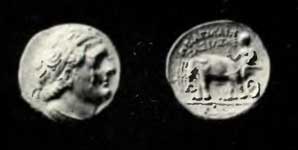
Head of Ptolemy I, diadem, wearing aegis.
Elephant quadriga driven by Alexander the Great as son of Zeus Ammon, holding reins in left and thunderbolt in right hand; in exergue, spray of silphium, Text Basileos Ptolemaiou
Battles
Some notable battles involving war elephants include:
- 331 BC, Battle of Gaugamela
- 326 BC, Battle of the Hydaspes River
- 312 BC, Battle of Gaza
- 301 BC, Battle of Ipsus
- 280 BC, Battle of Heraclea
- 279 BC, Battle of Asculum
- 217 BC, Battle of Raphia
- 202 BC, Battle of Zama
- 190 BC, Battle of Magnesia
- 164 BC, Battle of Beth-zur
- 46 BC, Battle of Thapsus
- 1214, capture of Cremona by Frederick II, Holy Roman Emperor
War elephants in popular culture
Rudyard Kipling's The Jungle Book contains two stories in which war elephants appear, "Toomai of the Elephants" and "Her Majesty's Servants". J. R. R. Tolkien's fictional war-beast Oliphaunt is modelled on war elephants.
Age of Empires a real-time strategy computer game features war elephants as a melée or a ranged (elephant archers) unit.
References
- H. H. Scullard, The Elephant in the Greek and Roman World, New York, Cornell University Press, 1974.
- Holt, Frank L. Alexander the Great and the Mystery of the Elephant Medallions-, California: University of California Press, 2003, 217pgs. ISBN 0520244834
Links
- Military Use of Elephants in the Greek and Roman Period (http://www.barca.fsnet.co.uk/elephants-war-greek.htm)
- Elephants in Sri Lankan History and Culture (http://www.artsrilanka.org/essays/elephants/index.html)
Novels
An Elephant for Aristotle
Index Military
| Ancient Greece
Science, Technology , Medicine , Warfare, , Biographies , Life , Cities/Places/Maps , Arts , Literature , Philosophy ,Olympics, Mythology , History , Images
Medieval Greece / Byzantine Empire
Science, Technology, Arts, , Warfare , Literature, Biographies, Icons, History
Modern Greece
Cities, Islands, Regions, Fauna/Flora ,Biographies , History , Warfare, Science/Technology, Literature, Music , Arts , Film/Actors , Sport , Fashion
---
Cyprus
Greek-Library - Scientific Library
|
Retrieved from "http://en.wikipedia.org/"
All text is available under the terms of the GNU Free Documentation License
Greece
World
Index
Hellenica World










